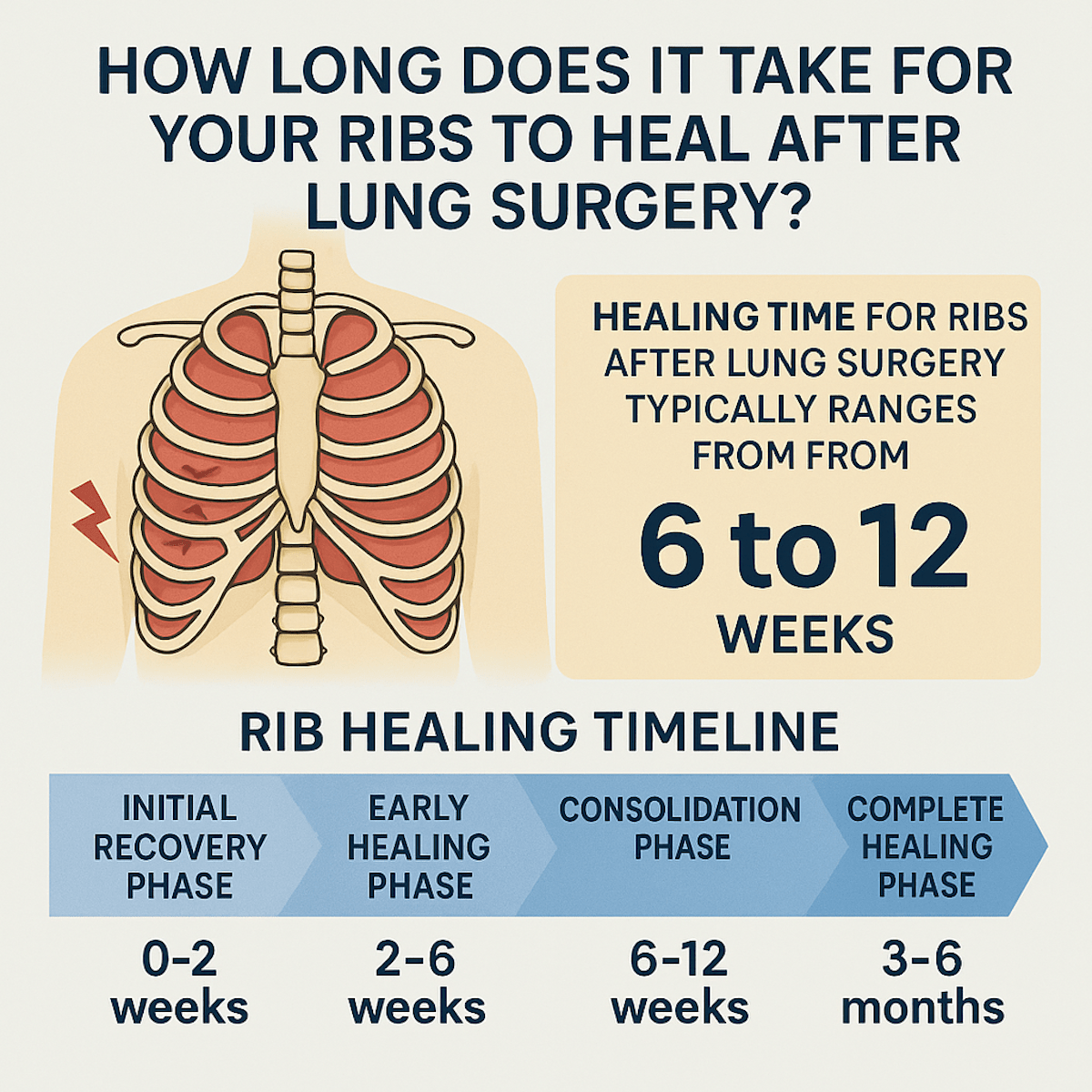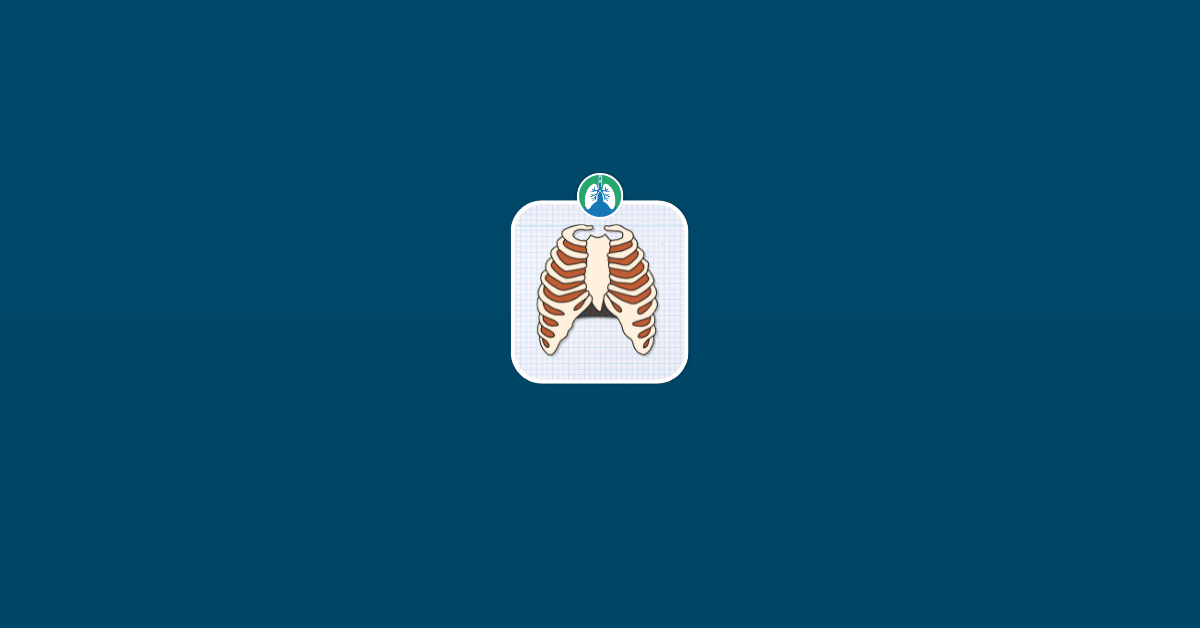Undergoing lung surgery is a major event that often involves more than just the lungs themselves. In many cases, surgeons must go through or around the ribs to reach the lung tissue, which can result in rib pain, bruising, or even fractures. This leads many patients to wonder just how long it takes for their ribs to fully heal after surgery.
The healing process can vary widely depending on the type of procedure, the patient’s overall health, and how the body responds to recovery.
Understanding what to expect during rib healing can help ease anxiety, improve outcomes, and guide post-operative care. In this article, we’ll explore the typical recovery timeline and what you can do to support healing.
Download our free guide that has over 100+ of the best tips for healthy lungs.
How Long Does it Take for Your Ribs to Heal After Lung Surgery?
Healing time for your ribs after lung surgery typically ranges from 6 to 12 weeks, depending on the extent of the procedure and your overall health. If the surgeon needed to spread or cut through the ribs to access the lungs, recovery might take longer.
You may experience pain, tenderness, or stiffness in the chest during this period, which usually improves gradually. Most patients are encouraged to begin light movement and breathing exercises shortly after surgery to prevent complications and promote healing.
Full recovery, including regaining normal strength and lung function, may take several months. Following your surgeon’s aftercare instructions and attending follow-up appointments is essential for proper healing and to monitor for potential complications like infection or poor wound healing.

Understanding the Surgical Impact on Ribs
During most lung surgeries, surgeons must access the thoracic cavity by working between or through the ribs. The specific approach depends on the type of procedure being performed. In traditional open thoracotomy, surgeons typically make an incision along the side of the chest and may need to spread the ribs apart to gain adequate access to the lungs.
This process can cause significant stress to the rib structure, including the bones themselves, the cartilage connections, and the surrounding muscles and tissues.
In some cases, particularly with more complex procedures or when better visualization is needed, surgeons may need to remove a portion of a rib or cut through it entirely. This more invasive approach naturally extends the healing timeline and requires additional considerations during recovery.
Minimally invasive procedures, such as video-assisted thoracoscopic surgery (VATS), typically cause less trauma to the rib structure since they involve smaller incisions and specialized instruments. However, even these procedures can result in some degree of rib stress and require healing time.
The Rib Healing Timeline
The healing process for ribs after lung surgery follows a predictable pattern, though individual recovery times can vary significantly based on multiple factors. Understanding this timeline helps patients prepare mentally and physically for the recovery journey ahead.
Initial Recovery Phase (0-2 weeks)
The first two weeks following lung surgery represent the most critical period for rib healing. During this time, patients typically experience the most significant pain and discomfort. The body immediately begins the inflammatory response, which is the first stage of bone healing. This phase involves increased blood flow to the affected area, swelling, and the formation of a blood clot around any bone trauma.
Pain management is crucial during this period, as adequate pain control allows patients to breathe deeply and cough effectively, which is essential for preventing pneumonia and other lung complications. Most patients will require prescription pain medications, and the pain may be most intense during the first week before gradually beginning to improve.
Early Healing Phase (2-6 weeks)
Between the second and sixth weeks, the body begins forming new bone tissue around any areas of rib damage. This process, called callus formation, creates a bridge of new bone that helps stabilize the healing rib. During this time, patients often notice a gradual improvement in pain levels, though discomfort may still be significant with certain movements or activities.
The soft callus that forms during this period is relatively weak and can be easily disrupted, which is why activity restrictions remain important. Patients are typically advised to avoid lifting anything heavier than 10-15 pounds and to refrain from activities that involve twisting or sudden movements of the torso.
Consolidation Phase (6-12 weeks)
The consolidation phase represents a crucial period where the soft callus begins to harden and strengthen. This process, called remodeling, involves the replacement of the initial callus with stronger, more organized bone tissue. Most patients experience significant improvement in pain and function during this period.
By the end of this phase, many patients can return to light activities and may be cleared for driving, depending on their surgeon’s recommendations and their ability to perform an emergency stop without significant pain. However, full contact sports and heavy lifting typically remain restricted.
Complete Healing Phase (3-6 months)
Complete rib healing generally takes between three to six months, though this timeline can extend longer in some cases. During this final phase, the bone continues to remodel and strengthen, eventually returning to near-normal structural integrity. The exact timeline depends on various factors, including the patient’s age, overall health, smoking status, and the extent of the surgical procedure.
Factors Affecting Healing Time
Several factors can significantly influence how quickly ribs heal after lung surgery. Understanding these variables helps explain why recovery times vary so dramatically between patients.
Age and Overall Health
Age is one of the most significant factors affecting bone healing. Younger patients typically heal faster due to more active bone metabolism and better overall circulation. Older adults may experience slower healing due to decreased bone density, reduced blood flow, and the presence of other health conditions that can impair recovery.
Overall health status plays a crucial role in healing. Patients with diabetes, autoimmune disorders, or other chronic conditions may experience delayed healing. Additionally, nutritional status significantly impacts bone healing, with deficiencies in calcium, vitamin D, and protein potentially slowing the process.
Smoking and Substance Use
Smoking is one of the most detrimental factors for bone healing. Nicotine restricts blood flow to healing tissues, while other chemicals in tobacco smoke interfere with bone formation. Patients who smoke may experience healing times that are 50-100% longer than non-smokers, and they have a higher risk of complications such as non-union (failure of the bone to heal properly).
Excessive alcohol consumption also negatively impacts bone healing by interfering with bone formation and reducing the body’s ability to absorb essential nutrients needed for recovery.
Surgical Approach and Complexity
The specific surgical technique used significantly affects rib healing time. Traditional open thoracotomy typically results in more rib trauma and longer healing times compared to minimally invasive approaches. Procedures that require rib removal or cutting through ribs naturally take longer to heal than those that simply involve spreading the ribs apart.
The complexity and duration of the surgery also play roles, as longer procedures may result in more tissue trauma and inflammation, potentially extending the healing timeline.
Post-Surgical Care and Compliance
Following post-operative instructions is crucial for optimal healing. Patients who adhere to activity restrictions, take medications as prescribed, and attend follow-up appointments typically heal faster and with fewer complications. Conversely, those who resume activities too quickly or neglect their recovery protocols may experience setbacks or prolonged healing times.
Managing Pain and Promoting Healing
Effective pain management is essential not only for comfort but also for promoting proper healing. Adequate pain control allows patients to breathe deeply, cough effectively, and participate in necessary activities like walking, all of which are important for overall recovery.
Medication Management
Pain medications are typically prescribed in a stepped approach, beginning with stronger medications in the immediate post-operative period and gradually transitioning to over-the-counter options as healing progresses. It’s important to take pain medications as prescribed rather than waiting until pain becomes severe, as this approach provides better overall pain control and prevents the development of chronic pain patterns.
Physical Therapy and Movement
While rest is important in the early stages of recovery, gentle movement and breathing exercises become increasingly important as healing progresses. Physical therapy may be recommended to help restore normal movement patterns and prevent complications such as frozen shoulder or muscle weakness.
Deep breathing exercises and incentive spirometry are crucial for preventing pneumonia and maintaining lung function during recovery. These exercises may be uncomfortable initially due to rib pain, but they become easier as healing progresses.
Nutritional Support
Proper nutrition plays a vital role in bone healing. Adequate protein intake is essential for tissue repair, while calcium and vitamin D are crucial for bone formation. Some patients may benefit from nutritional supplements, particularly if they have dietary restrictions or absorption issues.
Warning Signs and When to Seek Medical Attention
While some discomfort during rib healing is normal, certain symptoms warrant immediate medical attention. Patients should contact their healthcare provider if they experience increasing pain after an initial period of improvement, signs of infection such as fever or redness around the incision, difficulty breathing that worsens over time, or any chest pain that feels different from their usual post-surgical discomfort.
Additionally, if healing seems to plateau or pain doesn’t improve according to the expected timeline, further evaluation may be necessary to rule out complications such as non-union or other healing problems.
Final Thoughts
Rib healing after lung surgery is a gradual process that typically takes three to six months for complete recovery, though significant improvement often occurs within the first six to eight weeks. Understanding this timeline helps patients set realistic expectations and participate actively in their recovery process.
The key to successful rib healing lies in following medical recommendations, maintaining good nutrition, avoiding smoking and excessive alcohol, and gradually increasing activity levels as healing progresses. While the recovery process can be challenging, most patients ultimately achieve excellent outcomes with proper care and patience.
Each patient’s healing journey is unique, and it’s important to work closely with the surgical team to ensure optimal recovery. Regular follow-up appointments allow healthcare providers to monitor healing progress and adjust treatment plans as needed, ensuring the best possible outcome for each individual patient.
Written by:
John Landry is a registered respiratory therapist from Memphis, TN, and has a bachelor's degree in kinesiology. He enjoys using evidence-based research to help others breathe easier and live a healthier life.
References
- Mikheev AV, Trushin SN, Ogoreltsev AY. The evolution of operative access in lung surgery. Kardiochir Torakochirurgia Pol. 2021.


